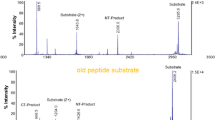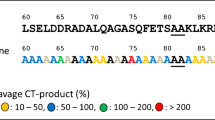Abstract
Botulinum neurotoxins (BoNT) are divided into seven toxinotypes based on their immunological properties and each toxinotype contains several subtypes according to their amino acid sequences. Here, we designed a mass spectrometry method able to identify BoNT/A subtypes in complex matrices including crude culture supernatants, food, and environmental samples. Peptides from BoNT light chain (L) specific to the subtypes BoNT/A1 to A3 and BoNT/A5 to A8 were identified. The method consists of an immunocapture step with antibodies specific to BoNT/A L chains followed by liquid chromatography–tandem mass spectrometry (LC–MS/MS) on a triple quadrupole mass spectrometer (QqQ) in multiple reaction monitoring (MRM) mode. BoNT/A subtypes were correctly identified in culture supernatants and in tap water or orange juice samples with a limit of detection of 20 to 150 mouse lethal doses (MLD) and with a lower sensitivity in serum samples.



Similar content being viewed by others
References
Rossetto O, Pirazzini M, Montecucco C (2014) Botulinum neurotoxins: genetic, structural and mechanistic insights. Nat Rev Microbiol 12(8):535–549. doi:10.1038/nrmicro3295
Simpson LL (2004) Identification of the major steps in botulinum toxin action. Annu Rev Pharmacol Toxicol 44:167–193
Sobel J (2005) Botulism. Clin Infect Dis 41(8):1167–1173
Popoff MR, Mazuet C, Poulain B (2013) Botulism and tetanus. In: The prokaryotes: human microbiology, vol 5. Human microbiology, 4° edn. Springer-Verlag, Berlin, pp 247–290
Lindström M, Korkeala H (2006) Laboratory diagnosis of botulism. Clin Microbiol Rev 19(2):298–314
Hill KK, Smith TJ (2013) Genetic diversity within Clostridium botulinum serotypes, botulinum neurotoxin gene clusters and toxin subtypes. Curr Top Microbiol Immunol 364:1–20
Smith TJ, Hill KK, Raphael BH (2014) Historical and current perspectives on Clostridium botulinum diversity. Res Microbiol 10(14):00187–00189
Smith TJ, Hill KK, Xie G, Foley BT, Williamson CH, Foster JT, Johnson SL, Chertkov O, Teshima H, Gibbons HS, Johnsky LA, Karavis MA, Smith LA (2015) Genomic sequences of six botulinum neurotoxin-producing strains representing three clostridial species illustrate the mobility and diversity of botulinum neurotoxin genes. Infect Genet Evol 30:102–113. doi:10.1016/j.meegid.2014.1012.1002
Mazuet C, King LA, Bouvet P, Legeay C, Sautereau J, Popoff MR (2014) Le botulisme humain en France, 2010–2012. BEH 6:106–114
Mazuet C, Ezan E, Volland H, Popoff MR, Becher F (2012) Toxin detection in patients' sera by mass spectrometry during two outbreaks of type A botulism in France. J Clin Microbiol 50(12):4091–4094. doi:10.1128/JCM.02392-02312
Kull S, Schulz KM, Weisemann J, Kirchner S, Schreiber T, Bollenbach A, Dabrowski PW, Nitsche A, Kalb SR, Dorner MB, Barr JR, Rummel A, Dorner BG (2015) Isolation and functional characterization of the novel Clostridium botulinum neurotoxin A8 subtype. PLoS One 10(2):e0116381. doi:10.1371/journal.pone.0116381
Popoff MR, Bouvet P (2013) Genetic characteristics of toxigenic Clostridia and toxin gene evolution. Toxicon 75:63–89
Kozaki S, Nakaue S, Kamata Y (1995) Immunological characterization of the neurotoxin produced by Clostridium botulinum type A associated with infant botulism in Japan. Microbiol Immunol 39(10):767–774
Arndt ER, Jacobson MJ, Abola EE, Forsyth CM, Tepp WH, Marks JD, Johnson EA, Stevens ES (2006) A structural perspective of the sequence variability within botulinum neurotoxin subtypes A1–A4. J Mol Biol 362:733–742
Smith TJ, Lou J, Geren IN, Forsyth CM, Tsai R, Laporte SL, Tepp WH, Bradshaw M, Johnson EA, Smith LA, Marks JD (2005) Sequence variation within botulinum neurotoxin serotypes impacts antibody binding and neutralization. Infect Immun 73(9):5450–5457
Henkel JS, Jacobson M, Tepp W, Pier C, Johnson EA, Barbieri JT (2009) Catalytic properties of botulinum neurotoxin subtypes A3 and A4. Biochemistry 48(11):2522–2528
Ahmed SA, Byrne MP, Jensen M, Hines HB, Brueggemann E, Smith LA (2001) Enzymatic autocatalysis of botulinum A neurotoxin light chain. J Protein Chem 20(3):221–231
Whitemarsh RC, Tepp WH, Bradshaw M, Lin G, Pier CL, Scherf JM, Johnson EA, Pellett S (2013) Characterization of botulinum neurotoxin A subtypes 1 through 5 by investigation of activities in mice, in neuronal cell cultures, and in vitro. Infect Immun 81(10):3894–3902. doi:10.1128/IAI.00536-00513
Pier CL, Chen C, Tepp WH, Lin G, Janda KD, Barbieri JT, Pellett S, Johnson EA (2011) Botulinum neurotoxin subtype A2 enters neuronal cells faster than subtype A1. FEBS Lett 585(1):199–206
Torii Y, Kiyota N, Sugimoto N, Mori Y, Goto Y, Harakawa T, Nakahira S, Kaji R, Kozaki S, Ginnaga A (2011) Comparison of effects of botulinum toxin subtype A1 and A2 using twitch tension assay and rat grip strength test. Toxicon 57:93–99
Mukai Y, Shimatani Y, Sako W, Asanuma K, Nodera H, Sakamoto T, Izumi Y, Kohda T, Kozaki S, Kaji R (2014) Comparison between botulinum neurotoxin type A2 and type A1 by electrophysiological study in healthy individuals. Toxicon 81:32–36. doi:10.1016/j.toxicon.2013.1012.1012
Webb RP, Smith TJ, Wright P, Brown J, Smith LA (2009) Production of catalytically inactive BoNT/A1 holoprotein and comparison with BoNT/A1 subunit vaccines against toxin subtypes A1, A2, and A3. Vaccine 27(33):4490–4497
Barash JR, Arnon SS (2014) A novel strain of Clostridium botulinum that produces type B and type H botulinum toxins. J Infect Dis 209(2):183–191. doi:10.1093/infdis/jit1449
Dover N, Barash JR, Hill KK, Xie G, Arnon SS (2014) Molecular characterization of a novel botulinum neurotoxin type H gene. J Infect Dis 209(2):192–202. doi:10.1093/infdis/jit1450
Gonzalez-Escalona N, Thirunavukkarasu N, Singh A, Toro M, Brown EW, Zink D, Rummel A, Sharma SK (2014) Draft genome sequence of bivalent clostridium botulinum strain IBCA10-7060, encoding botulinum neurotoxin B and a new FA mosaic type. Genome Announc 2(6):e01275-01214. doi:10.1128/genomeA.01275-14
Hill KK, Smith TJ, Helma CH, Ticknor LO, Foley BT, Svensson RT, Brown JL, Johnson EA, Smith LA, Okinaka RT, Jackson PJ, Marks JD (2007) Genetic diversity among botulinum neurotoxin-producing clostridial strains. J Bacteriol 189(3):818–832
Tevell Aberg A, Bjornstad K, Hedeland M (2013) Mass spectrometric detection of protein-based toxins. Biosecur Bioterror 11(Suppl 1):S215–S226. doi:10.1089/bsp.2012.0072
Kalb SR, Goodnough MC, Malizio CJ, Pirkle JL, Barr JR (2005) Detection of botulinum neurotoxin A in a spiked milk sample with subtype identification through toxin proteomics. Anal Chem 77(19):6140–6146
Kalb SR, Baudys J, Rees JC, Smith TJ, Smith LA, Helma CH, Hill K, Kull S, Kirchner S, Dorner MB, Dorner BG, Pirkle JL, Barr JR (2012) De novo subtype and strain identification of botulinum neurotoxin type B through toxin proteomics. Anal Bioanal Chem 403(1):215–226. doi:10.1007/s00216-00012-05767-00213
Wang D, Baudys J, Rees J, Marshall KM, Kalb SR, Parks BA, Nowaczyk L 2nd, Pirkle JL, Barr JR (2012) Subtyping botulinum neurotoxins by sequential multiple endoproteases in-gel digestion coupled with mass spectrometry. Anal Chem 84:4652–4658
Leveque C, Ferracci G, Maulet Y, Mazuet C, Popoff M, Seagar M, El Far O (2014) Direct biosensor detection of botulinum neurotoxin endopeptidase activity in sera from patients with type A botulism. Biosens Bioelectron 57:207–212. doi:10.1016/j.bios.2014.02.015
Mazuet C, Dano J, Popoff MR, Creminon C, Volland H (2010) Characterization of botulinum neurotoxin type A neutralizing monoclonal antibodies and influence of their half-lives on therapeutic activity. PLoS One 5(8), e12416
Volland H, Lamourette P, Nevers MC, Mazuet C, Ezan E, Neuburger LM, Popoff M, Creminon C (2008) A sensitive sandwich enzyme immunoassay for free or complexed Clostridium botulinum neurotoxin type A. J Immunol Methods 330(1–2):120–129
Acknowledgements
We thank the toxicology department of DGA Maîtrise NRBC for its help with the animal experiments. This research was supported by grants from the Direction Générale de l’Armement and from Institut Pasteur.
Author information
Authors and Affiliations
Corresponding author
Rights and permissions
About this article
Cite this article
Morineaux, V., Mazuet, C., Hilaire, D. et al. Characterization of botulinum neurotoxin type A subtypes by immunocapture enrichment and liquid chromatography–tandem mass spectrometry. Anal Bioanal Chem 407, 5559–5570 (2015). https://doi.org/10.1007/s00216-015-8707-1
Received:
Revised:
Accepted:
Published:
Issue Date:
DOI: https://doi.org/10.1007/s00216-015-8707-1




